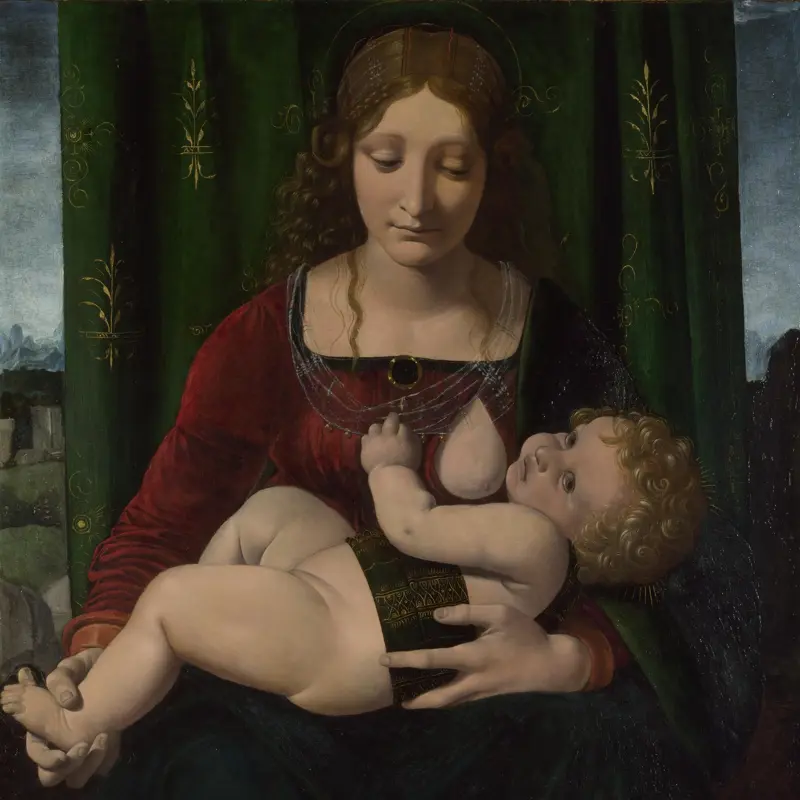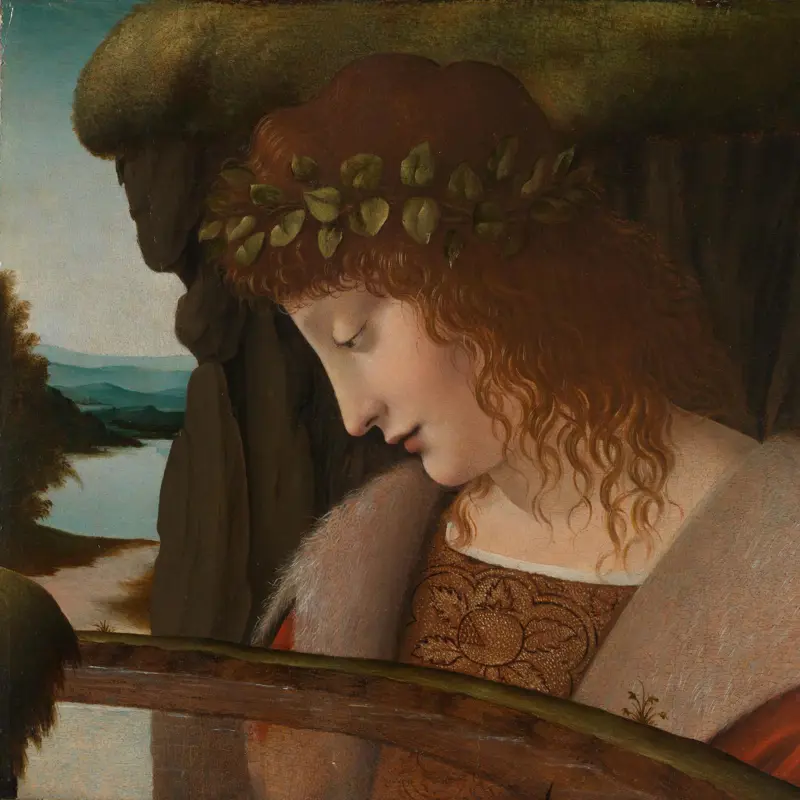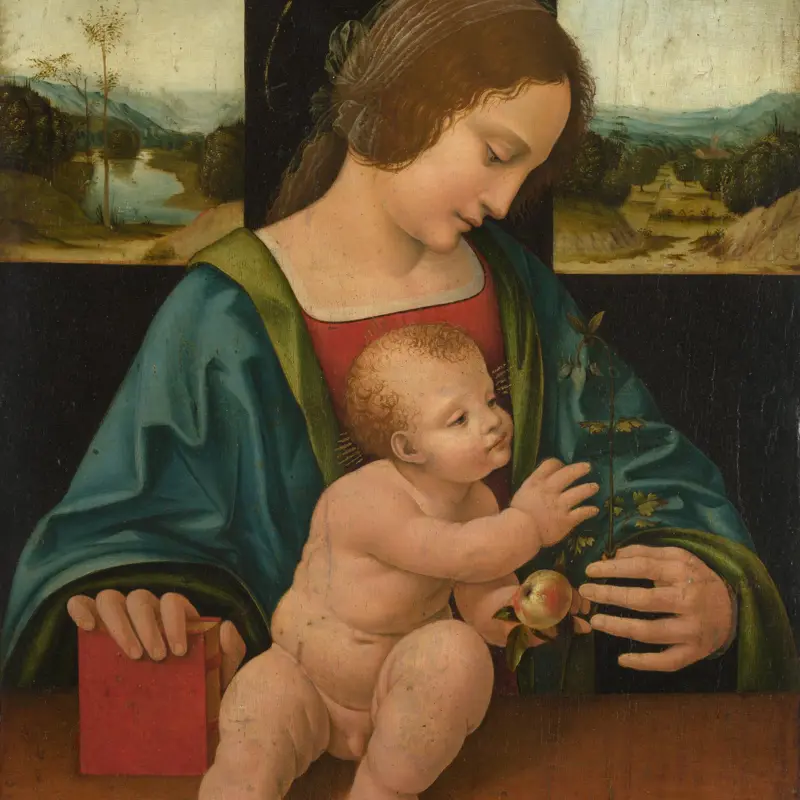Giovanni Antonio Boltraffio, 'Portrait of a Man in Profile', probably about 1500
About the work
Overview
The man in this portrait was once thought to be Gerolamo Casio, a poet from Bologna. He and Boltraffio knew one another and Casio even mentioned Boltraffio’s skill at painting in his sonnets.
This attractive idea is now doubted, but there’s no question that the work is by Boltraffio. One of Leonardo’s apprentices in Milan, Boltraffio adopted his master’s style more faithfully than any of his other students. His use of shadow to model the man’s jowls and the flesh of his nose resembles the style Leonardo developed in Milan. The profile view was outdated in most of Italy when this was painted – Leonardo himself favoured a broader view of his sitters' faces – but the Milanese courts were a little more conservative, so it persisted there for longer.
Key facts
Details
- Full title
- Portrait of a Man in Profile
- Artist
- Giovanni Antonio Boltraffio
- Artist dates
- about 1467 - 1516
- Date made
- probably about 1500
- Medium and support
- oil on wood
- Dimensions
- 57.5 × 43 cm
- Acquisition credit
- Mond Bequest, 1924
- Inventory number
- NG3916
- Location
- Not on display
- Collection
- Main Collection
- Previous owners
Provenance
Additional information
Text extracted from the ‘Provenance’ section of the catalogue entry in Martin Davies, ‘National Gallery Catalogues: The Earlier Italian Schools’, London 1986; for further information, see the full catalogue entry.
Bibliography
-
1898H.F. Cook, Catalogue of Pictures by Masters of the Milanese and Allied Schools of Lombardy, London 1898
-
1898G. Frizzoni, 'Exposition de maîtres de l'école lombarde à Londres', Gazette des beaux-arts, II, 1898
-
1898C. Phillips, 'English and Continental Art - New Gallery', Daily Telegraph, 1898
-
1910J.P. Richter, The Mond Collection: An Appreciation, London 1910
-
1911G. Frizzoni, 'La raccolta Mond ed opere attinenti alla medesima', Rassegna d'arte, XI, 1911, pp. 43-8
-
1912C.J. Ffoulkes, 'Il catalogo mond', L'arte, XV, 1912, pp. 263-80
-
1924A. Venturi, 'La quadreria di Ludwig Mond', L'arte, XXVII, 1924, pp. 200-10
-
1930R. Witt and A. Venturi, Exhibition of Italian Art 1200-1900, (exh. cat. Royal Academy of Arts, 1 January - 8 March 1930), London 1930
-
1951Davies, Martin, National Gallery Catalogues: The Earlier Italian Schools, London 1951
-
1951M. Reggiani Rajna, 'Un po'd'ordine fra tanti Casii', Rinascimento, II/3-4, 1951, pp. 337ff
-
1952M. Reggiano Rajna, 'L'unico allievo del Vinci Leonardo a Bologna e i ritratti di Girolamo Casio', Rivista del Comune di Bologna, 1952, pp. 21-32
-
1953C. Pedretti, Documenti e memorie riguardanti Leonardo da Vinci a Bologna e in Emilia, Bologna 1953
-
1959R.R. Henry, Giovanni Antonio Boltraffio: A Stylistic Study of His Work, Phd Thesis, Boston University Graduate School 1959
-
1961M. Davies, The Earlier Italian Schools, 2nd edn, London 1961
-
1983D.A. Brown, 'Leonardo and the Idealized Portrait in Milan', Arte lombarda, 67, 1983
-
1983E. Rama, 'Un tentativo di rilettura della ritrattistica di Boltraffio fra Quattrocento e Cinquecento', Arte lombarda, LXIV, 1983, pp. 79-92
-
1985C.T. Dowd, 'The Travel Diary of Otto Mündler', The Walpole Society, LI, 1985
-
1986Davies, Martin, National Gallery Catalogues: The Earlier Italian Schools, revised edn, London 1986
-
2001
C. Baker and T. Henry, The National Gallery: Complete Illustrated Catalogue, London 2001
About this record
If you know more about this work or have spotted an error, please contact us. Please note that exhibition histories are listed from 2009 onwards. Bibliographies may not be complete; more comprehensive information is available in the National Gallery Library.



